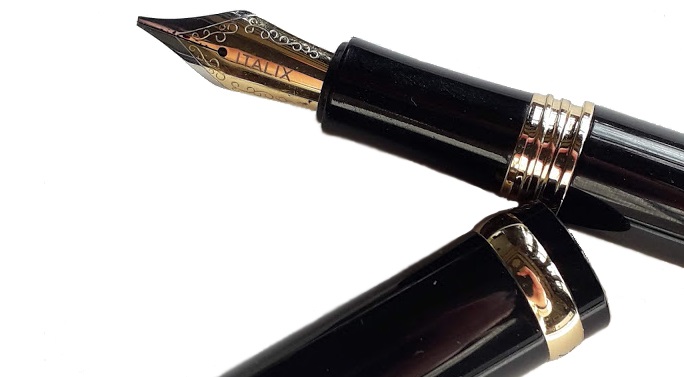Bedoooby-dooby-doooooby-doo, doobedy do do, doobedy-dooo, as Mr. Brubeck so memorably put it. But back in the non-jazz world, we know and love #5 as denoting one of the most popular sizes of nibs. But is it one size or two? No, it’s three. Hmm. Maybe we should give you the long version…
OK, here we go – and be warned, this will get geeky. Firstly, let’s cover what distinguishes a #5 nib from, say, a #6, or even a #8. An obscure mystery, surely? Well not really; the feed is 5 millimetres wide. That’s it.
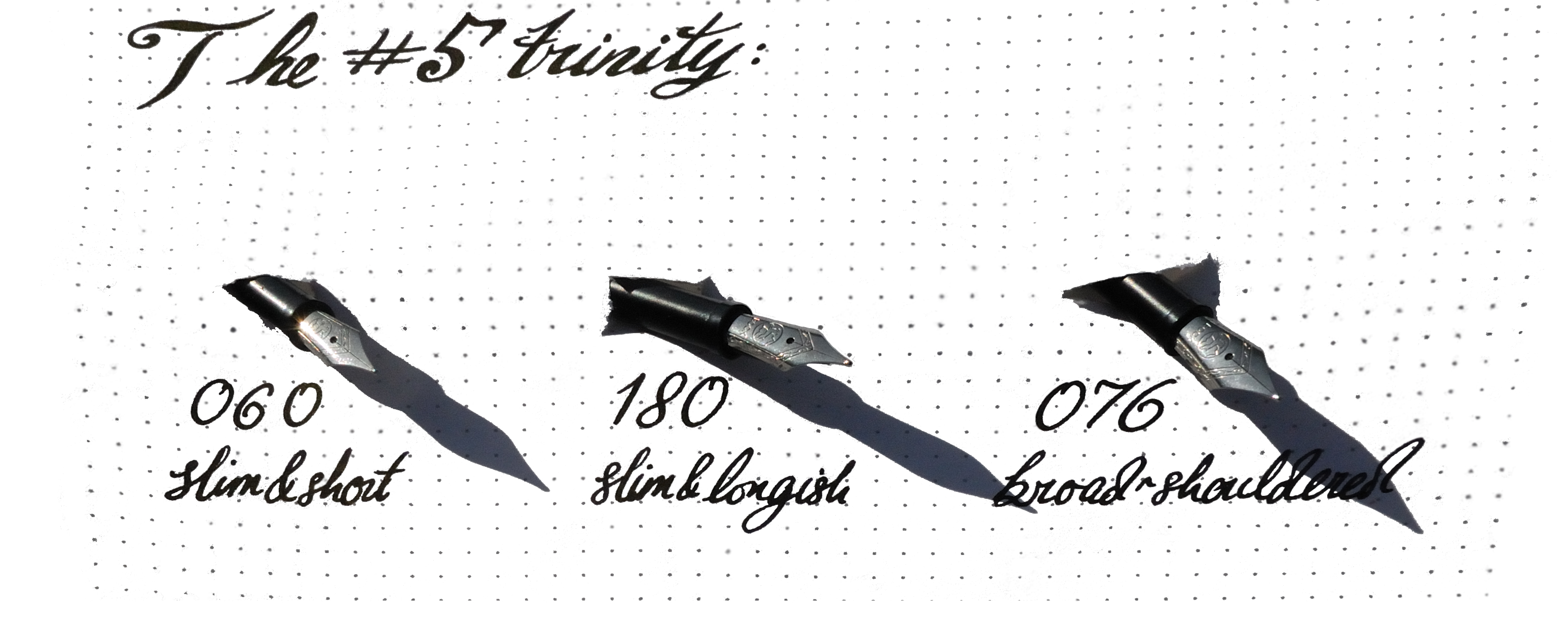
So how can there be so much confusion between small #5s, large #5s, and sort-of in-between #5s? Possibly because we don’t have clearly established names for them. But it turns out that, actually we do. In the language of nib-smiths Bock AG, they are the 060, the 180 and the 076, which might not be memorable labels but they could grow on you (you’ve read this far without dozing off, so there’s hope at least). The simple thing would be to just refer you to the handy guide on the Bock website, but that’s hardly the basis of a riveting article either.
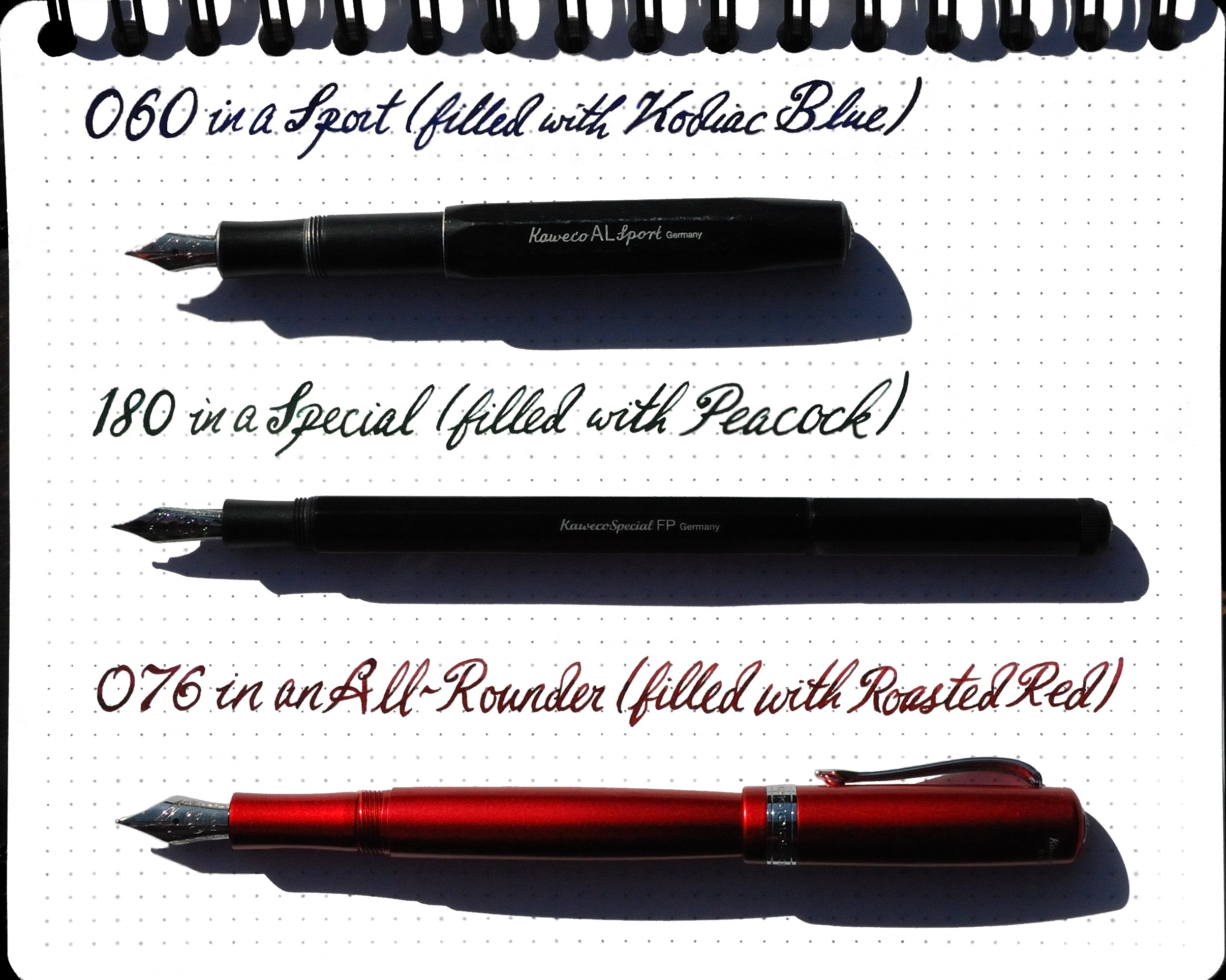
Instead of just reeling out some not-terribly-vital statistics, then, we turned to Phil from Beaufort nibs, who has many advantages over Peter Bock, not least still being with us in the land of the living, a convenient base in Devon, and the lack of a dubious toothbrush moustache (top tip: avoid this unless you actually are Charlie Chaplin). Phil kindly supplied a sample of each, which we fitted to appropriate products from another company which started out in Heidelberg, and filled with various shades of Beaufort ink.

So, let’s start with the version of #5 which you’re probably most familiar with, the humble but sturdy ‘short’ #5 which Bock calls the 060. The reason you’ll know it is, in all likelihood, because you’ve encountered one of two Kawecos; a Sport or a Lilliput. In both cases, the diminutive nib looks the part on a small pen, and with little space to spare in the cap it’s really the only practical choice. Nibs aren’t always perfectly tuned when straight from the factory, so a hands-on supplier like Phil can be good to know if you have one of these pens and fancy changing the business end. We fitted one to a ‘stonewashed’ Sport to put it through its paces. With a short slit measuring 0.85mm from tip to centre of the breather hole, there’s not much wiggle room here so line variation is rare in the steel version, although gold can have a bit of bounce if you ask nicely.
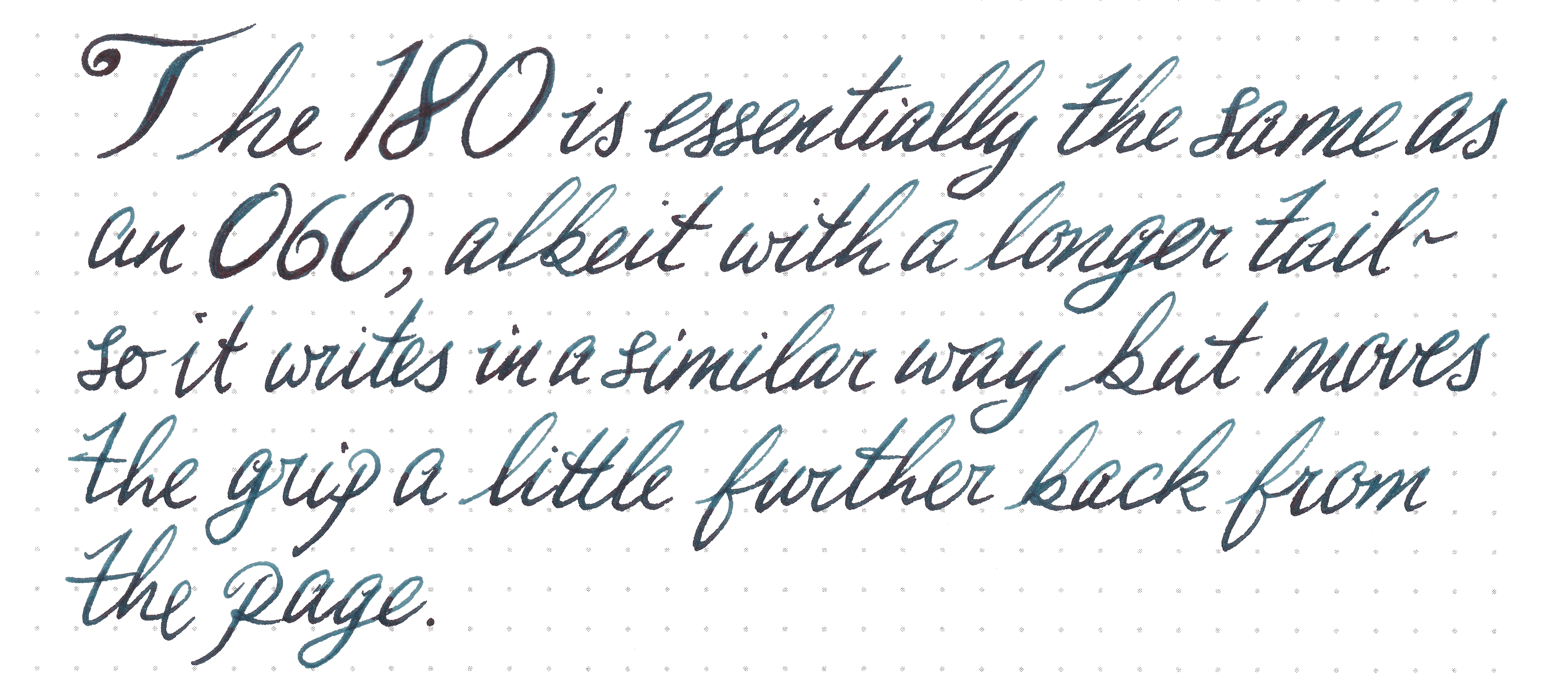
The middle option, sometimes referred to as a ‘standard’ #5 in the trade, is the 180, which is just as narrow as the 060 and with a slit only a millimetre longer, but a more generous tail on the back. You may have seen these on pens like the late lamented Dex, the affordably splendid Super 5 (the name’s a clue), and of course the TWSBI Eco. It can be fitted to Kaweco pens which are narrow but have longer caps, like the Special – so that’s what we did. ‘Worked a treat.
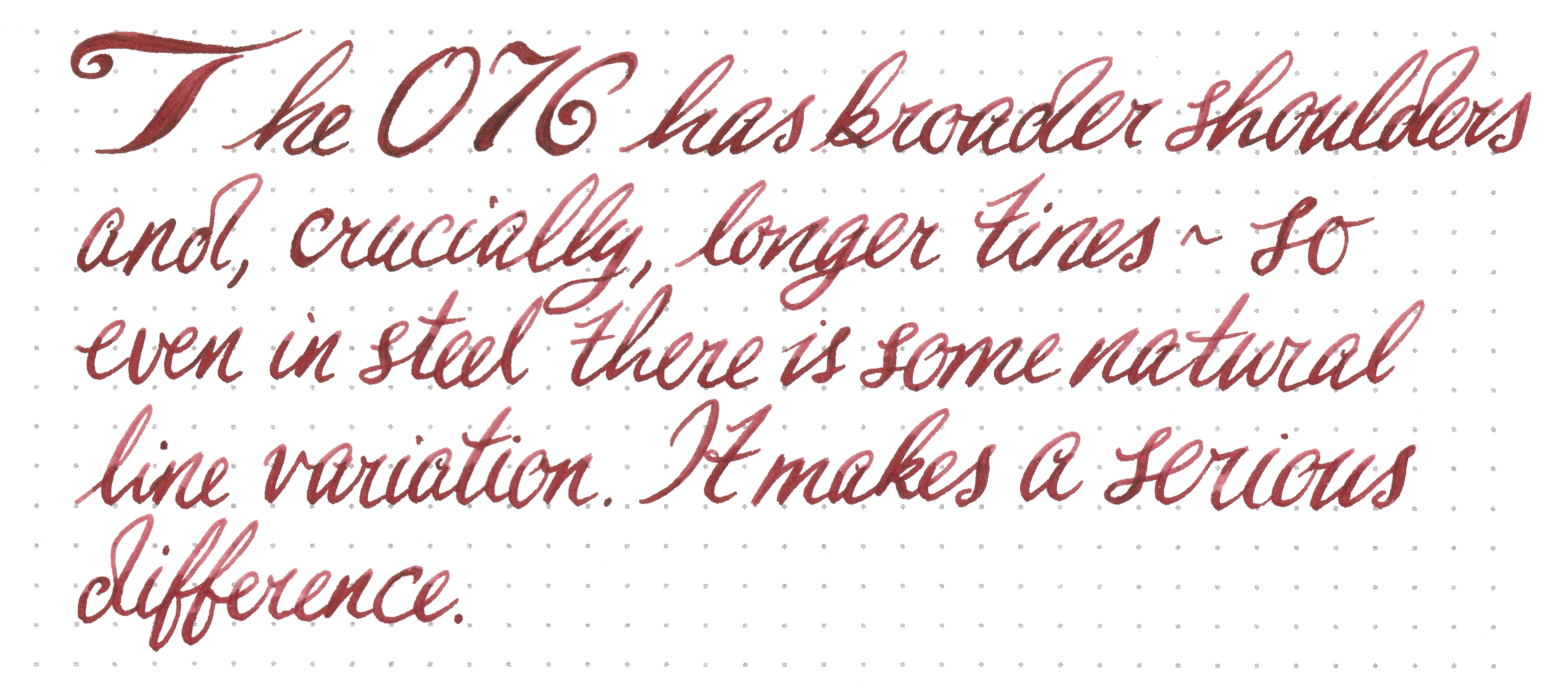
Last but literally not least, there’s the big bold 076, which despite boasting a smaller number than the 180 has considerably wider shoulders. More importantly, it has the longest slit of all three (10.5mm), and thus naturally more flexible tines, whatever the material. You’ll be used to this size of nib in pens like the TWSBI 580, and it also fits many of the larger Kawecos, including the sadly missed All-rounder, the Student and the Dia. On these fairly big pens it looks correctly proportioned, and works better too. Maybe Kaweco should fit them in the first place – although with a minimum order of 5,000 pieces, it’s perhaps understandable that they haven’t yet rushed. In the meantime, have fun experimenting yourself!
In the spirit of fairness we should also mention that lots of other manufacturers offer #5 nibs too, sometimes even in new shapes like JoWo’s ‘arrow’ unit – but by golly life would be simpler if they’d adopt a straightforward numbering system…
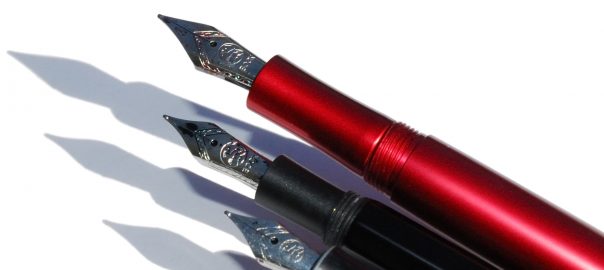
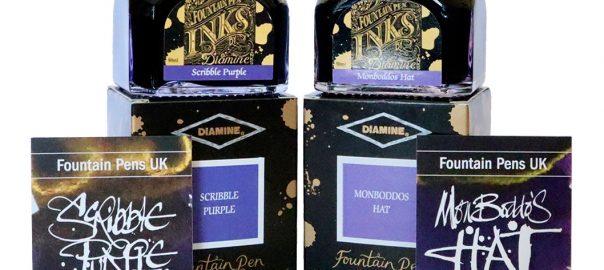

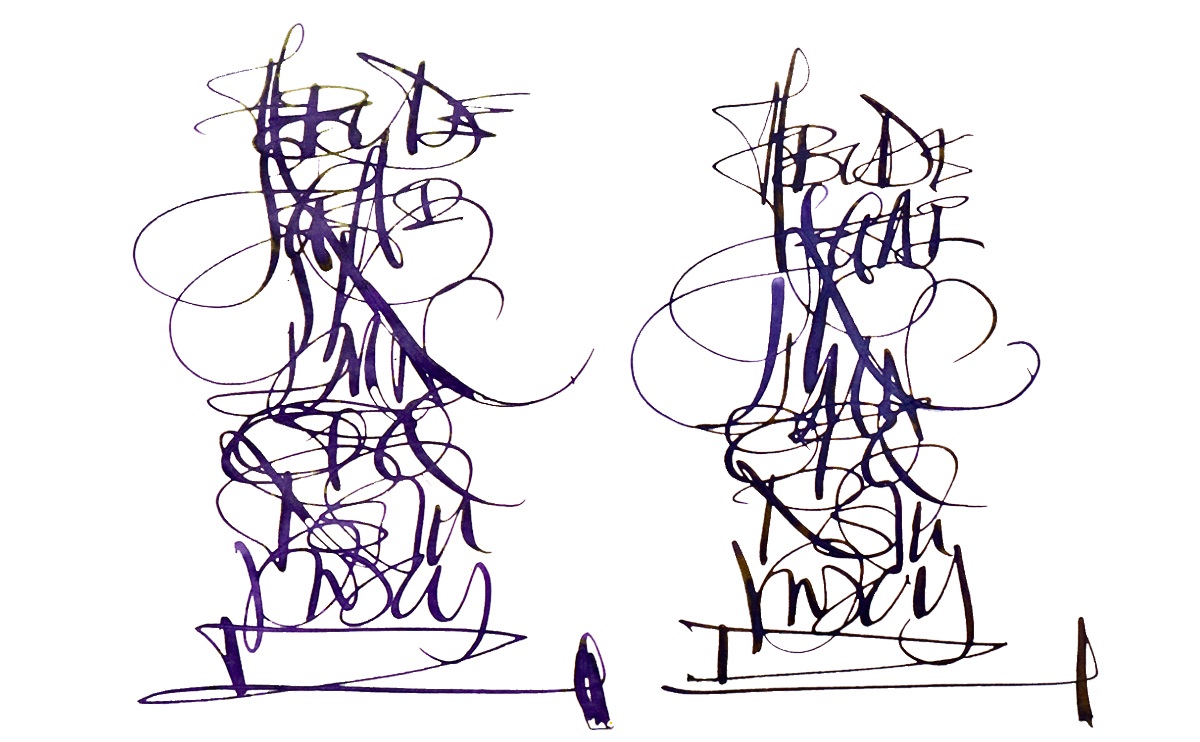
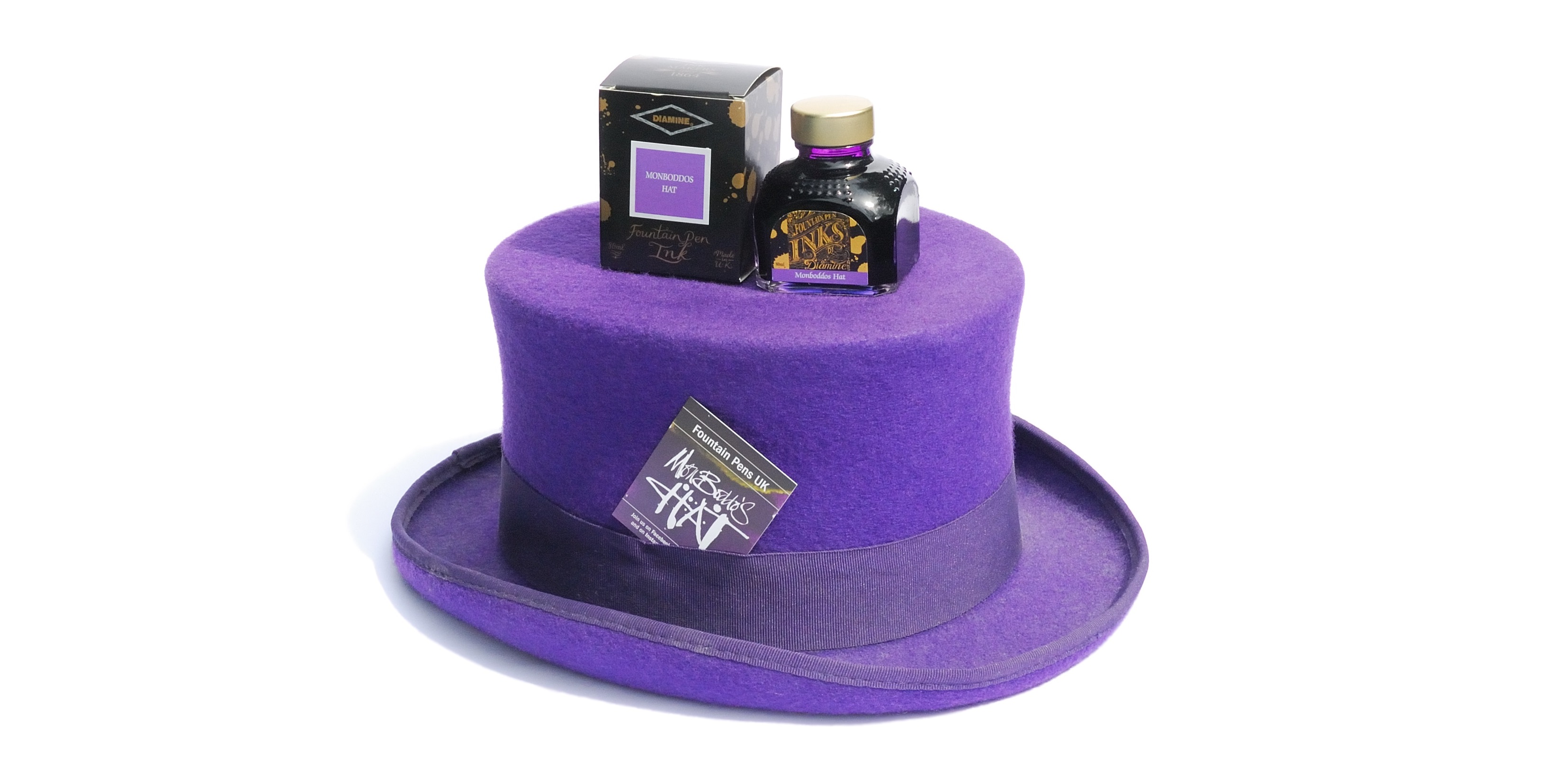
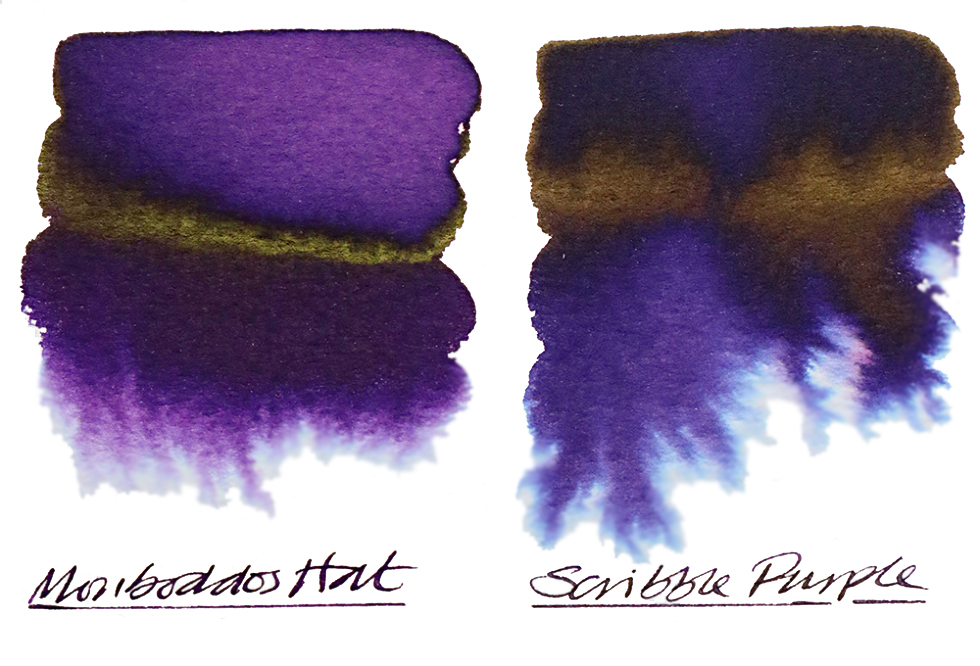

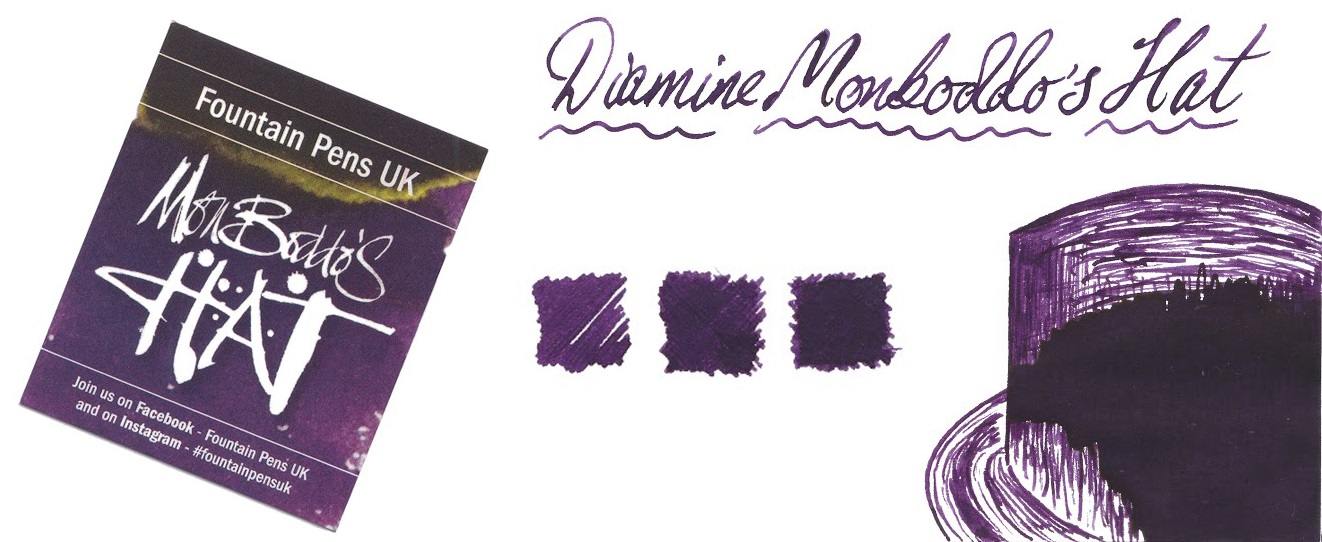
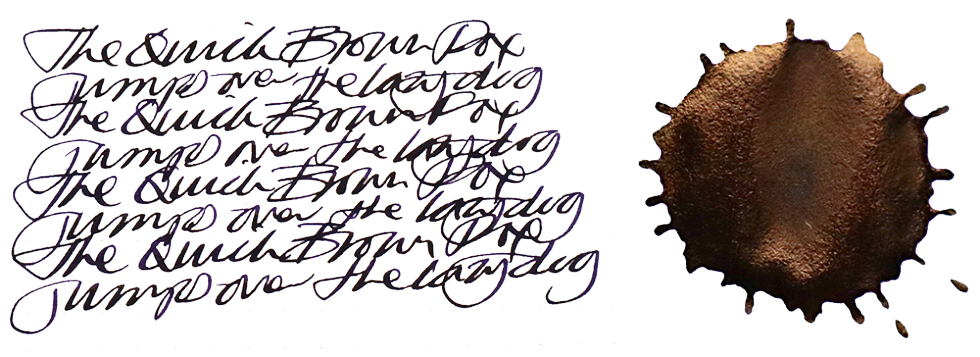

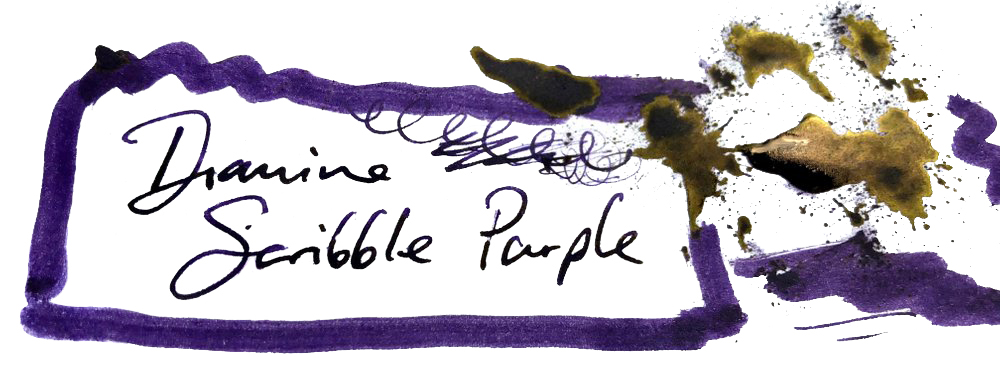


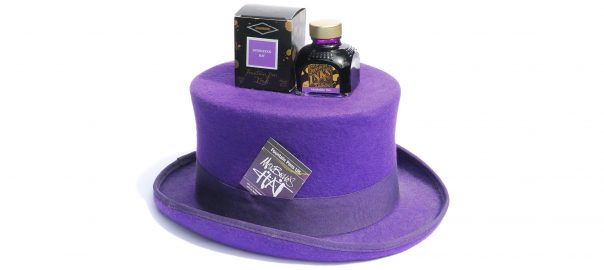
 We start with a hat-tip to fellow stationery bloggers who run a news and update service of their own – but we don’t see them as competitors, because it’s a small world out there – positively a nanosphere, in fact. A subscription to the
We start with a hat-tip to fellow stationery bloggers who run a news and update service of their own – but we don’t see them as competitors, because it’s a small world out there – positively a nanosphere, in fact. A subscription to the  Talking of hat-tips, the Fountain Pens UK group on Farcebook have collaborated with Diamine to produce two terrific inks,
Talking of hat-tips, the Fountain Pens UK group on Farcebook have collaborated with Diamine to produce two terrific inks, 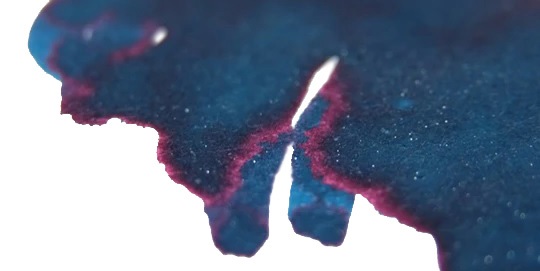 Diamine are all over the electric high street at the moment, with a new ink to celebrate fifteen years of Cymru’s finest nibtacular retail establishment, Pure Pens. Their
Diamine are all over the electric high street at the moment, with a new ink to celebrate fifteen years of Cymru’s finest nibtacular retail establishment, Pure Pens. Their 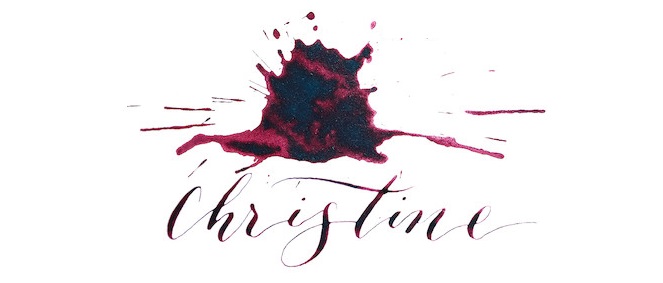 Not be outdone, Cult Pens have exercised Diamine’s finest minds and then named inks after them – and thus Chris and Phil can now now fill your converters as well as answering your emails. Philip, in particular, is a
Not be outdone, Cult Pens have exercised Diamine’s finest minds and then named inks after them – and thus Chris and Phil can now now fill your converters as well as answering your emails. Philip, in particular, is a 
 …while Andy’s Pens now include a cheeky Vac700 impersonator, the
…while Andy’s Pens now include a cheeky Vac700 impersonator, the  Write Here’s ex-OMAS friends at ScriBo are sticking with greens and blues so far, but the latest incarnation is looking
Write Here’s ex-OMAS friends at ScriBo are sticking with greens and blues so far, but the latest incarnation is looking  Beyond these shores, Californian firm Ensso are back on Kickstarter with a very tempting metal offering, the
Beyond these shores, Californian firm Ensso are back on Kickstarter with a very tempting metal offering, the  Finally, something to look forward to if we survive Hallowe’en after all. Roy from the mighty Izods is organising a new pen show just south of Marylebone on the 13th June 2020, and there are even rumours of Robert Oster flying in himself! Watch this space…
Finally, something to look forward to if we survive Hallowe’en after all. Roy from the mighty Izods is organising a new pen show just south of Marylebone on the 13th June 2020, and there are even rumours of Robert Oster flying in himself! Watch this space…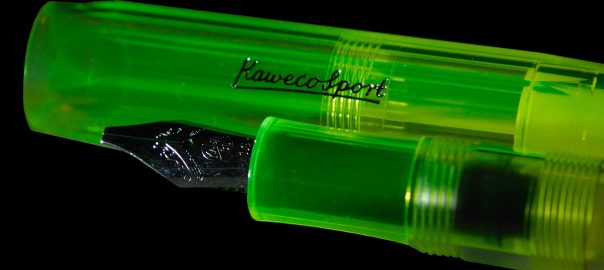
 A little bit of history On the other side of the Atlantic, different religious sects still have their own universities; you can, if you so wish, attend seats of learning gathered under the sway of belief systems not even recognised by the rest of the world, but we shall name no names. A Jesuit university is a relatively mainstream concept compared with some of the more outré outliers, albeit perhaps a surprising place to train as an industrial chemist – but Frank Honn graduated from one such, and went on to discover a novel use for the fluorescent dye pyranine as the first highlighting ink. It was a success, by any standards, and generations of pupils have grown up with felt-tip pens full of the stuff ever since. But felt-tips are horrible, and fountain pens are not, so Kaweco set out to make a highlighter that persons of taste might actually be able to contemplate using.
A little bit of history On the other side of the Atlantic, different religious sects still have their own universities; you can, if you so wish, attend seats of learning gathered under the sway of belief systems not even recognised by the rest of the world, but we shall name no names. A Jesuit university is a relatively mainstream concept compared with some of the more outré outliers, albeit perhaps a surprising place to train as an industrial chemist – but Frank Honn graduated from one such, and went on to discover a novel use for the fluorescent dye pyranine as the first highlighting ink. It was a success, by any standards, and generations of pupils have grown up with felt-tip pens full of the stuff ever since. But felt-tips are horrible, and fountain pens are not, so Kaweco set out to make a highlighter that persons of taste might actually be able to contemplate using.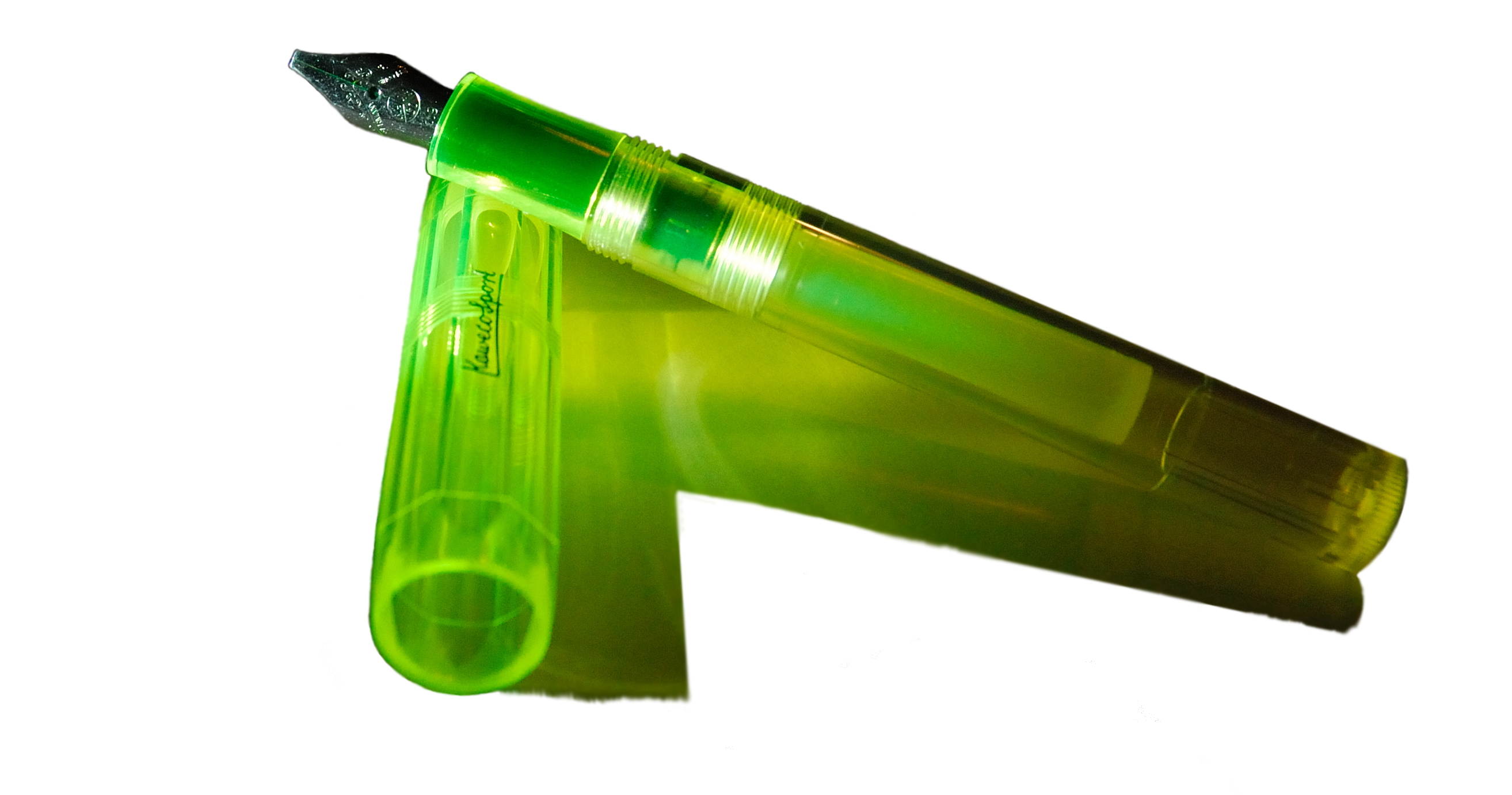 How it looks Did we say this was tasteful? Well, maybe it depends upon your own taste! It’s certainly rather loud – but there’s no mistaking what it’s for.
How it looks Did we say this was tasteful? Well, maybe it depends upon your own taste! It’s certainly rather loud – but there’s no mistaking what it’s for.
 How it fills Via cartridges specially filled with unworldly glowing fluids.
How it fills Via cartridges specially filled with unworldly glowing fluids.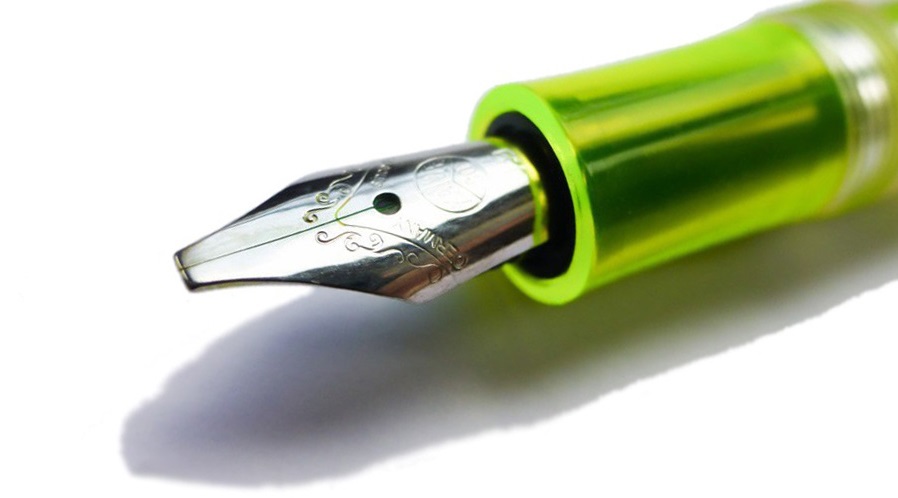
 Pen! What is it good for? It’s good for making up documents for editing or review, of course. It would probably also be good for baffling pen thieves in the work place; this is one pen which the ballpoint brigade won’t know where to even start with!
Pen! What is it good for? It’s good for making up documents for editing or review, of course. It would probably also be good for baffling pen thieves in the work place; this is one pen which the ballpoint brigade won’t know where to even start with!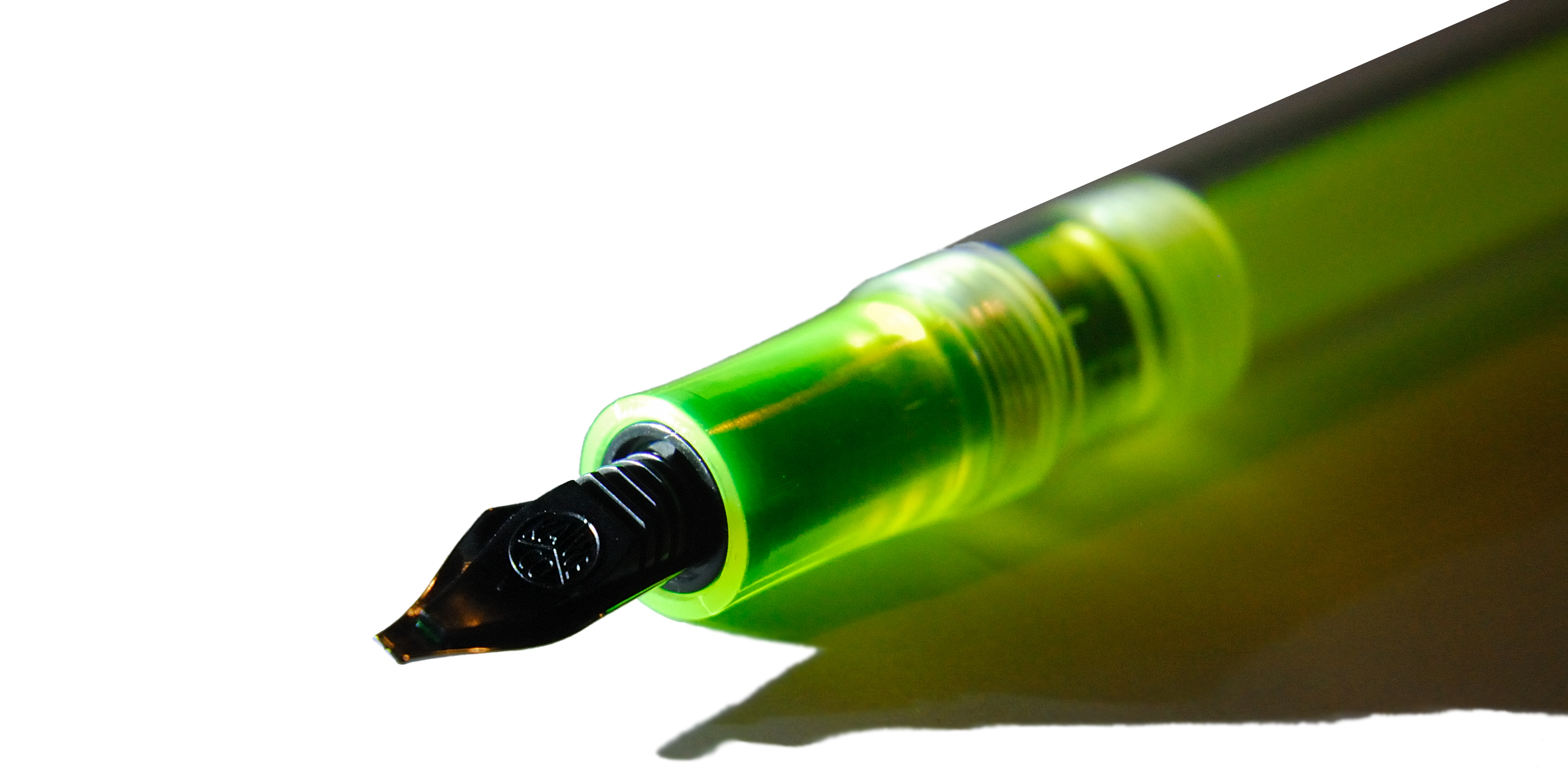 VFM Shop around a bit and you can get this set, complete with a box of cartridges, for less than £30. Admittedly that would buy a lot of nasty cheap disposable highlighters, but you’d hate them – and this will probably last for decades. Fair value, then.
VFM Shop around a bit and you can get this set, complete with a box of cartridges, for less than £30. Admittedly that would buy a lot of nasty cheap disposable highlighters, but you’d hate them – and this will probably last for decades. Fair value, then.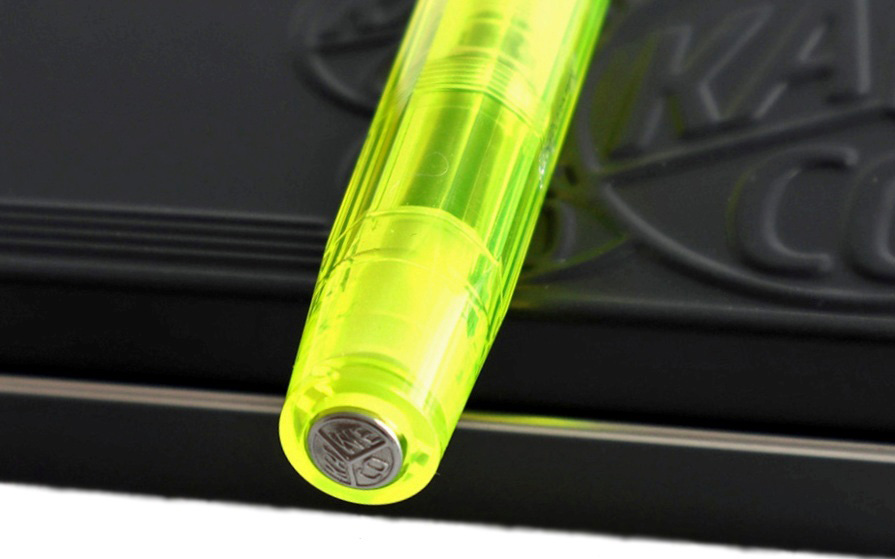
 Our overall recommendation Think about whether you really do all that much highlighting, and perhaps invest in a pack of the highlighter ink cartridges first to see if you take to using an italic fountain pen for this purpose – but if the answer to both is yes then this is, like pyranine, a ready solution.
Our overall recommendation Think about whether you really do all that much highlighting, and perhaps invest in a pack of the highlighter ink cartridges first to see if you take to using an italic fountain pen for this purpose – but if the answer to both is yes then this is, like pyranine, a ready solution.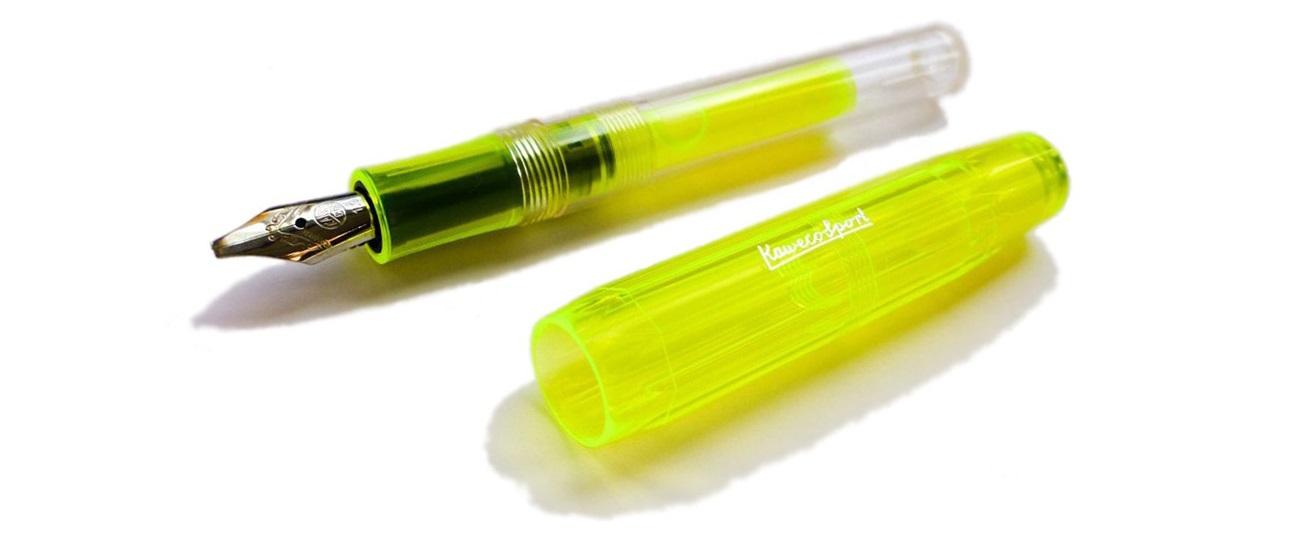
 This meta-review references:
This meta-review references: Thanks to Kaweco for the review sample.
Thanks to Kaweco for the review sample.





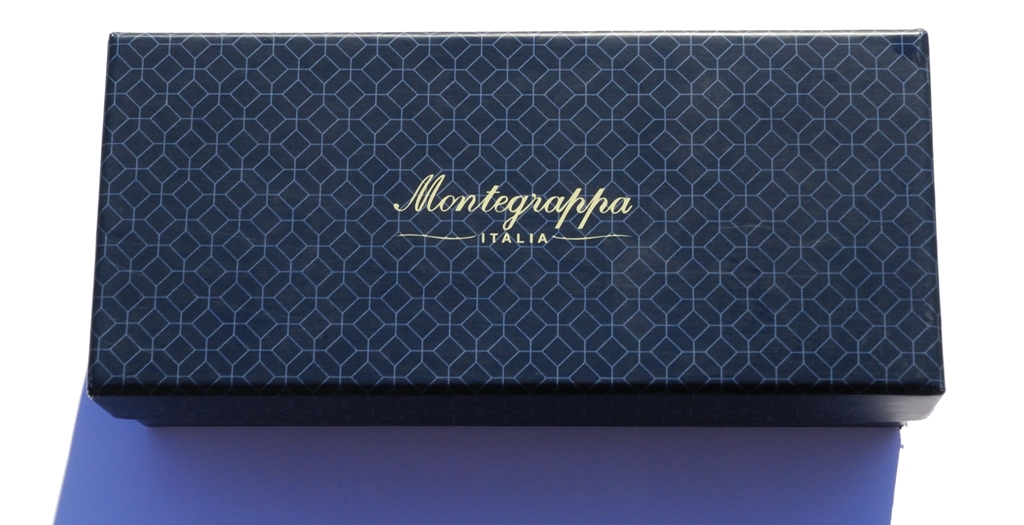

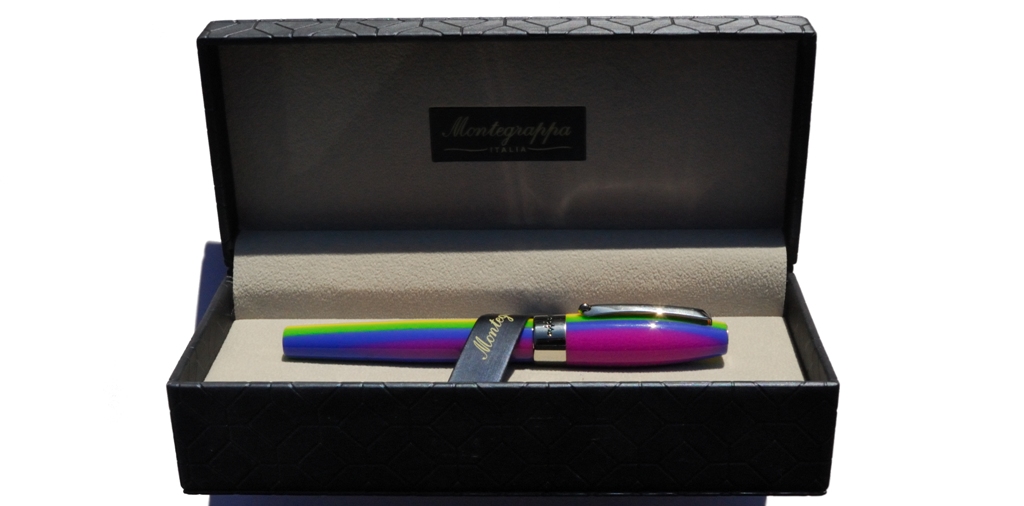
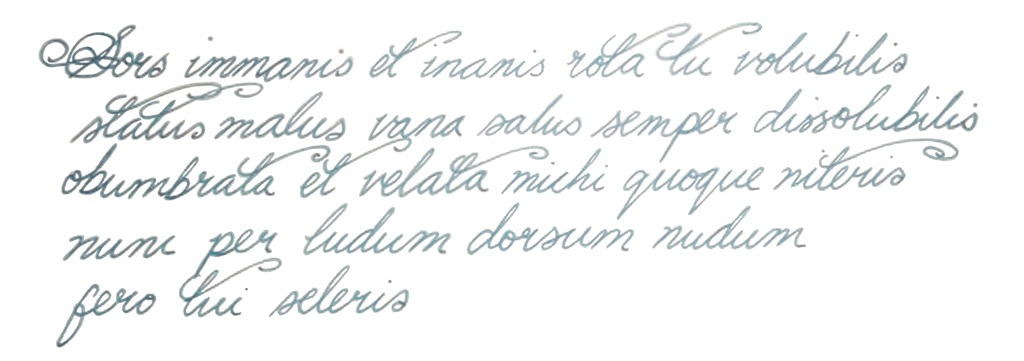
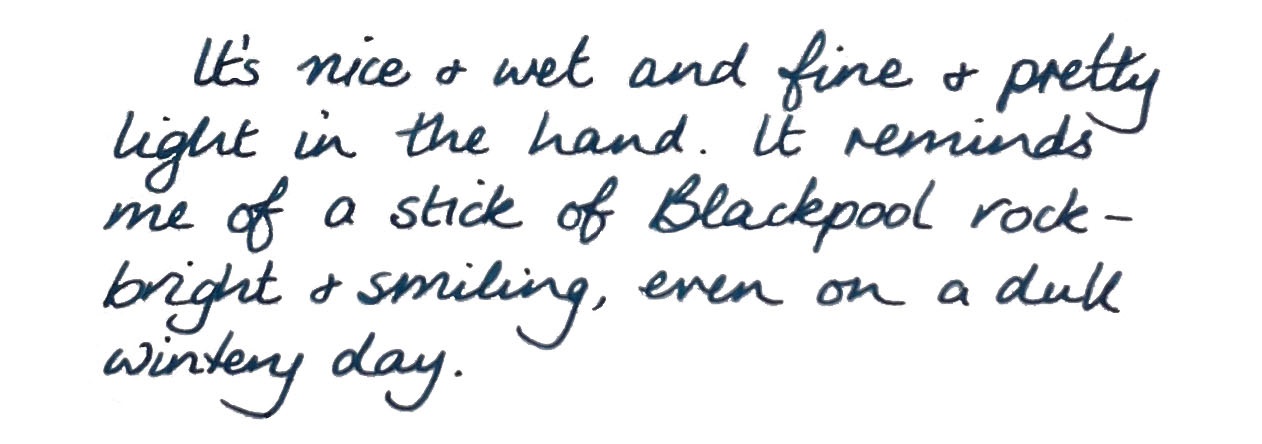


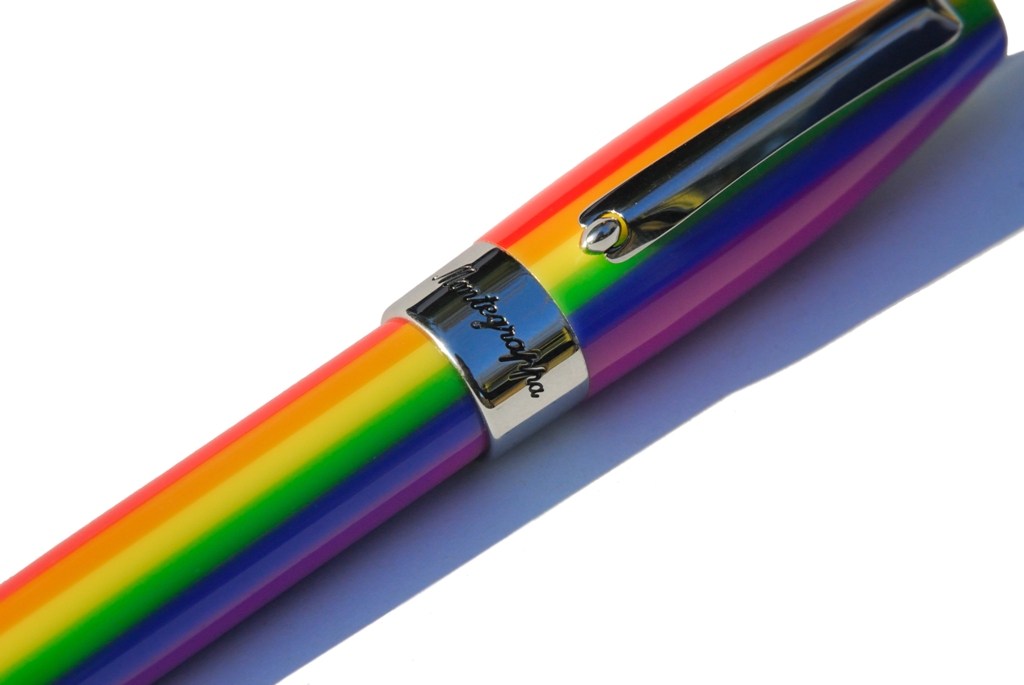
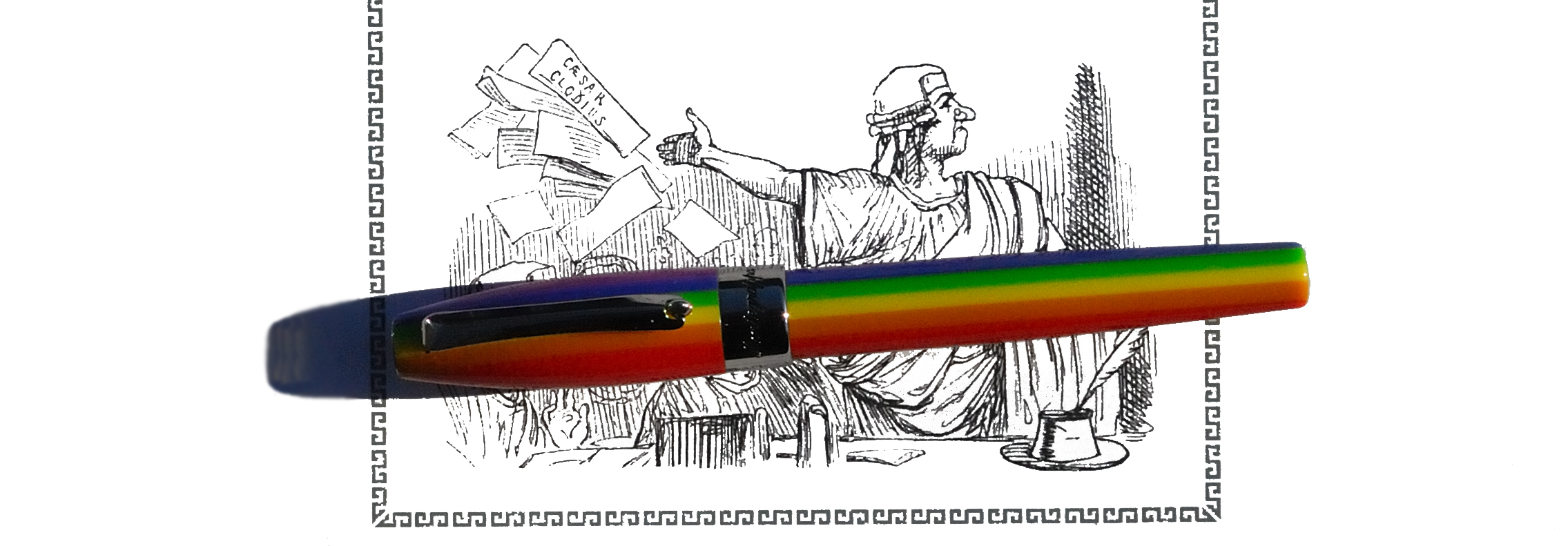 Our overall recommendation If you love the look, and can find it on special offer, go for it – then switch to a JoWo or Bock business end.
Our overall recommendation If you love the look, and can find it on special offer, go for it – then switch to a JoWo or Bock business end. Where to get hold of one If you want to spend £230 on this steel-nibbed pen – and, admittedly, get a pashmina thrown-in to the deal – then try
Where to get hold of one If you want to spend £230 on this steel-nibbed pen – and, admittedly, get a pashmina thrown-in to the deal – then try 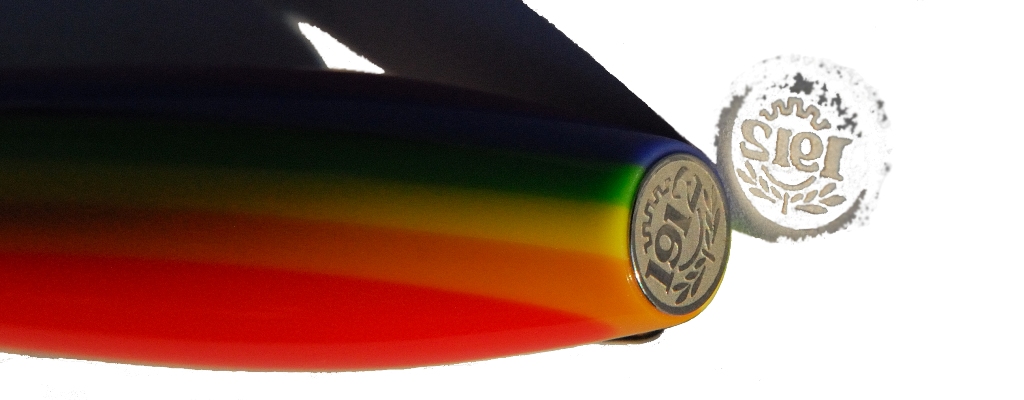


 How it looks Very deep red, matt, lustrous and slightly shiny. Paired with the pencil and popped into a ‘chilli red’ sleeve, it looks irresistibly good.
How it looks Very deep red, matt, lustrous and slightly shiny. Paired with the pencil and popped into a ‘chilli red’ sleeve, it looks irresistibly good. How it feels Light but tactile. Unless you specifically prefer heavier pens like the brass Sport (as some of us do!), this is a good mid-point on the mass spectrum.
How it feels Light but tactile. Unless you specifically prefer heavier pens like the brass Sport (as some of us do!), this is a good mid-point on the mass spectrum.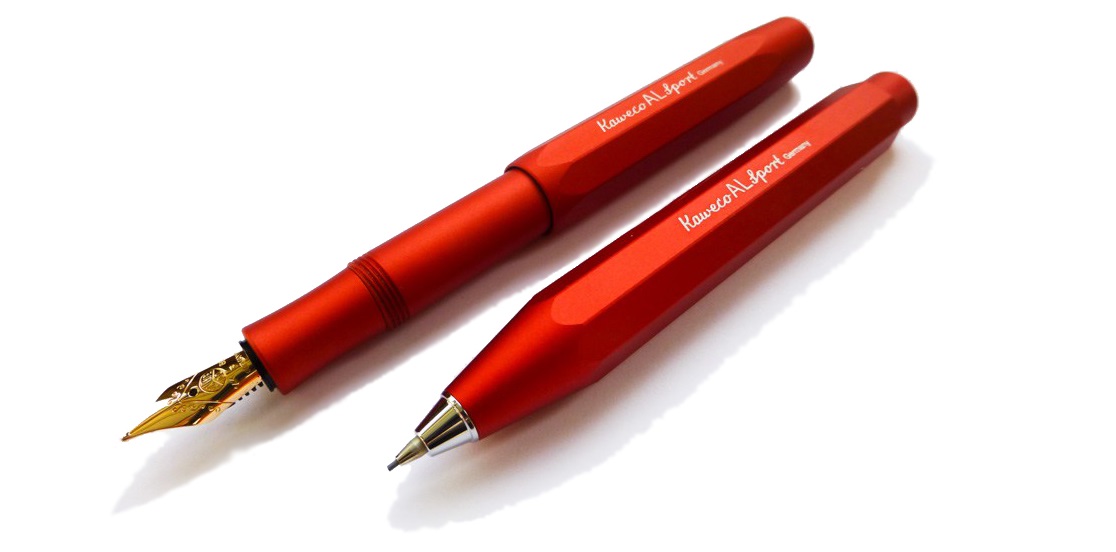 How it fills As with all Sports this is a straightforward short international cartridge number. There is a converter, and it does work, but the fluid capacity is so limited that investing in a syringe is often the best tactic for long-term cohabitation with this petite performer. The pencil takes 0.7mm lead, and there’s plenty of that around.
How it fills As with all Sports this is a straightforward short international cartridge number. There is a converter, and it does work, but the fluid capacity is so limited that investing in a syringe is often the best tactic for long-term cohabitation with this petite performer. The pencil takes 0.7mm lead, and there’s plenty of that around.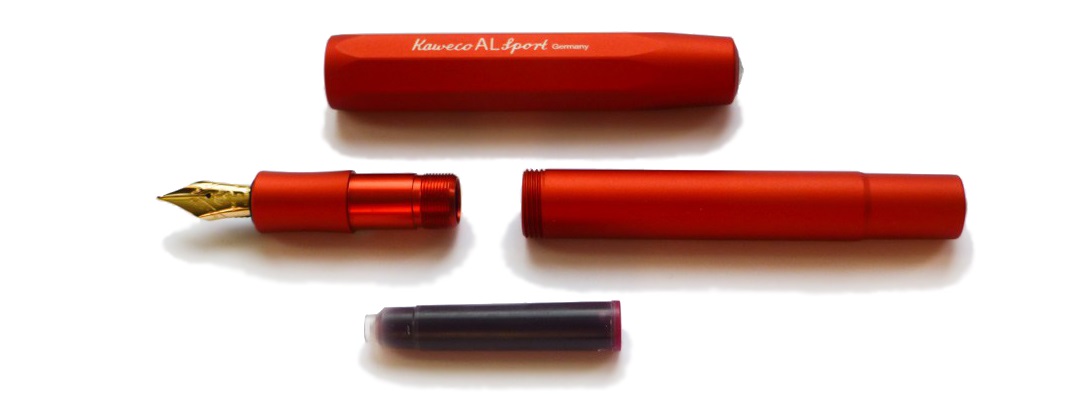 Crucially, how it writes… We rather decadently dropped a gold nib into the test pen, and it wrote very nicely; not much springiness, but just a touch of softness. The standard nibs are getting better these days, too!
Crucially, how it writes… We rather decadently dropped a gold nib into the test pen, and it wrote very nicely; not much springiness, but just a touch of softness. The standard nibs are getting better these days, too!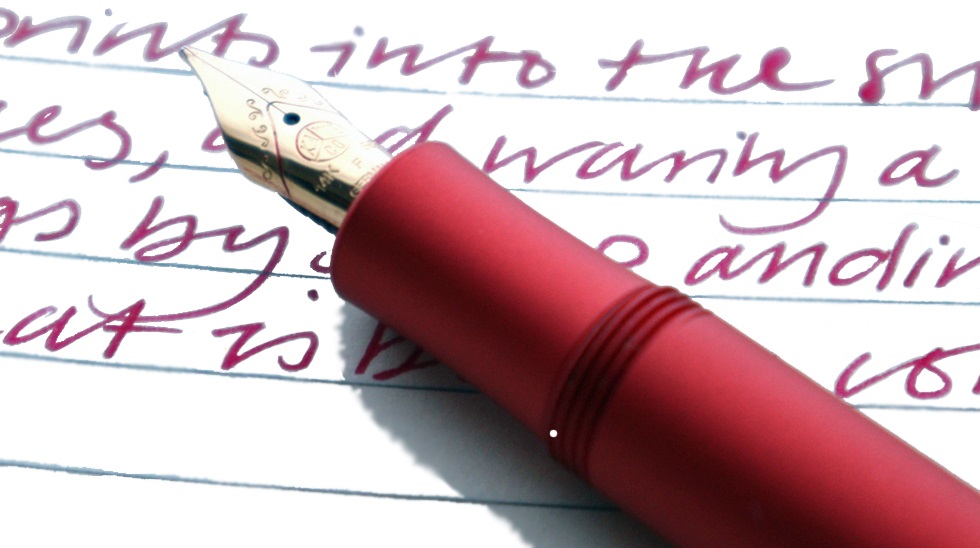
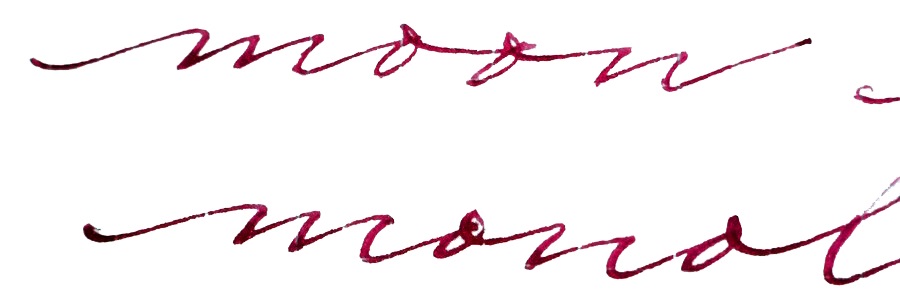
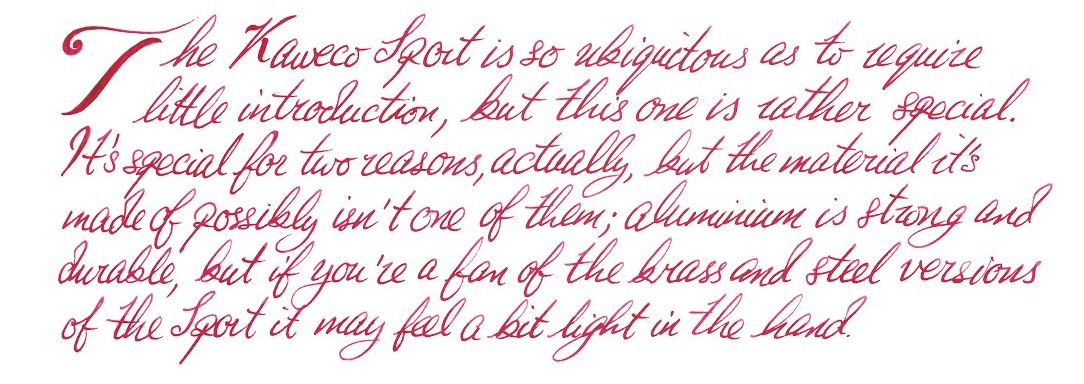
 VFM Middling, honestly. At around £60 this is not a cheap pen, and it will probably cost you more than that on top to get the gold nib. Having said that, this is not a crazily overpriced pen either.
VFM Middling, honestly. At around £60 this is not a cheap pen, and it will probably cost you more than that on top to get the gold nib. Having said that, this is not a crazily overpriced pen either. If this isn’t quite your cup of tea, but almost… One of the hundred or so other Sport finishes might well be. Have a browse…
If this isn’t quite your cup of tea, but almost… One of the hundred or so other Sport finishes might well be. Have a browse… Our overall recommendation If you’re taken with this finish, get one while you can; although we think it’s excellent, it was a special edition so it may not be available forever.
Our overall recommendation If you’re taken with this finish, get one while you can; although we think it’s excellent, it was a special edition so it may not be available forever.
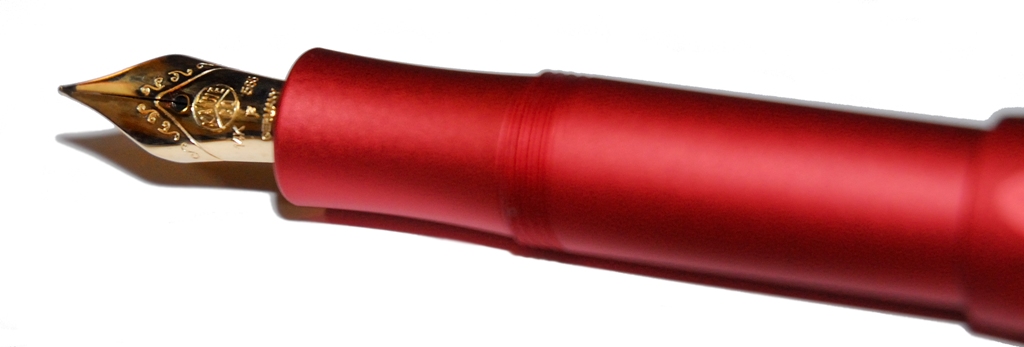
 Thanks to Kaweco for the rather tempting review sample pack; our calligrapher couldn’t bear to let it go!
Thanks to Kaweco for the rather tempting review sample pack; our calligrapher couldn’t bear to let it go!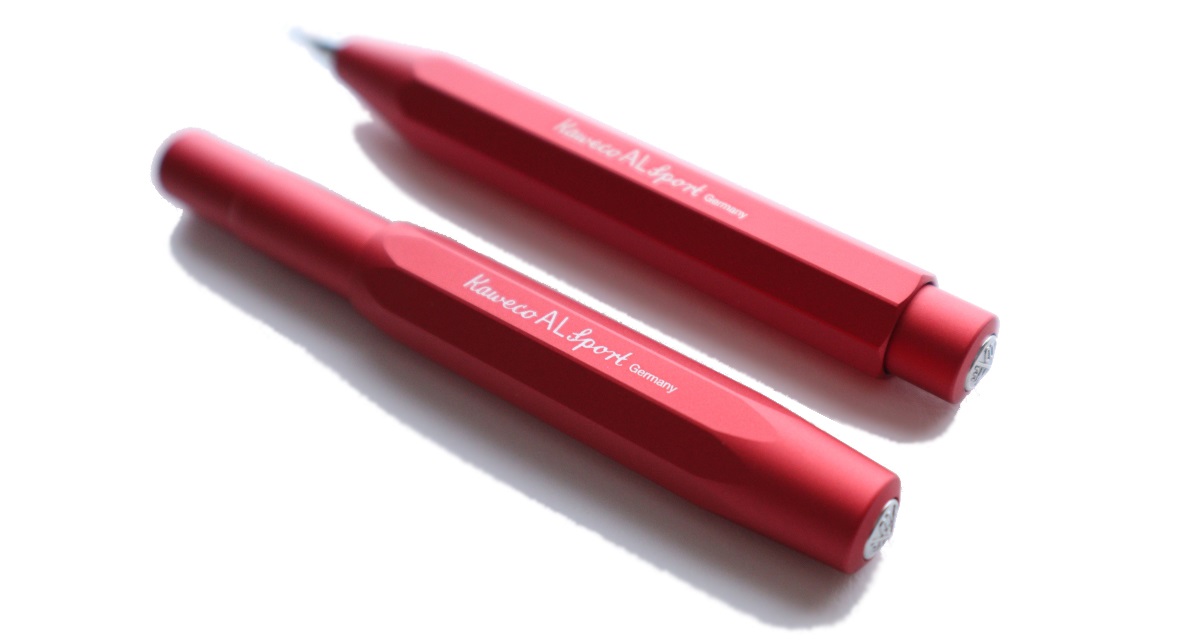
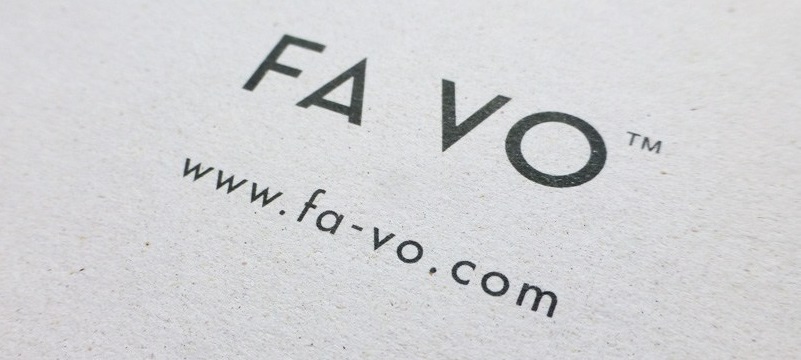

 Crucially, how it handles a fountain pen… As previously mentioned, the notebook uses recycled paper – so what you’re getting isn’t going to be akin to the great writing experience of, say, Clairefontaine. However, it was pleasantly surprising, because for recycled paper this did quite well. We noticed some bleed and minor show-through, but we could also see some shading and a slight amount of sheen on certain tests. So it’s reassuring that the writing won’t look ‘flat’ and without dimension on the page.
Crucially, how it handles a fountain pen… As previously mentioned, the notebook uses recycled paper – so what you’re getting isn’t going to be akin to the great writing experience of, say, Clairefontaine. However, it was pleasantly surprising, because for recycled paper this did quite well. We noticed some bleed and minor show-through, but we could also see some shading and a slight amount of sheen on certain tests. So it’s reassuring that the writing won’t look ‘flat’ and without dimension on the page.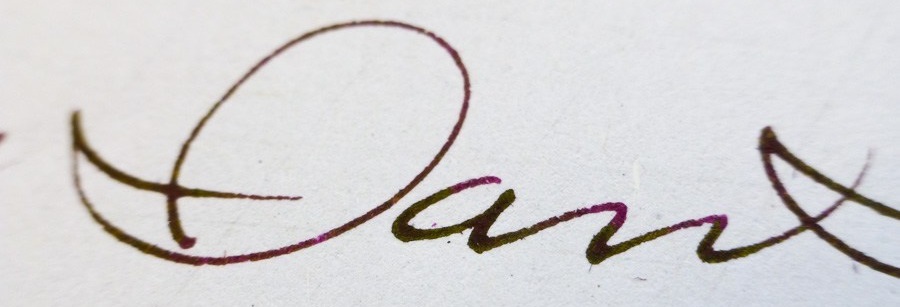

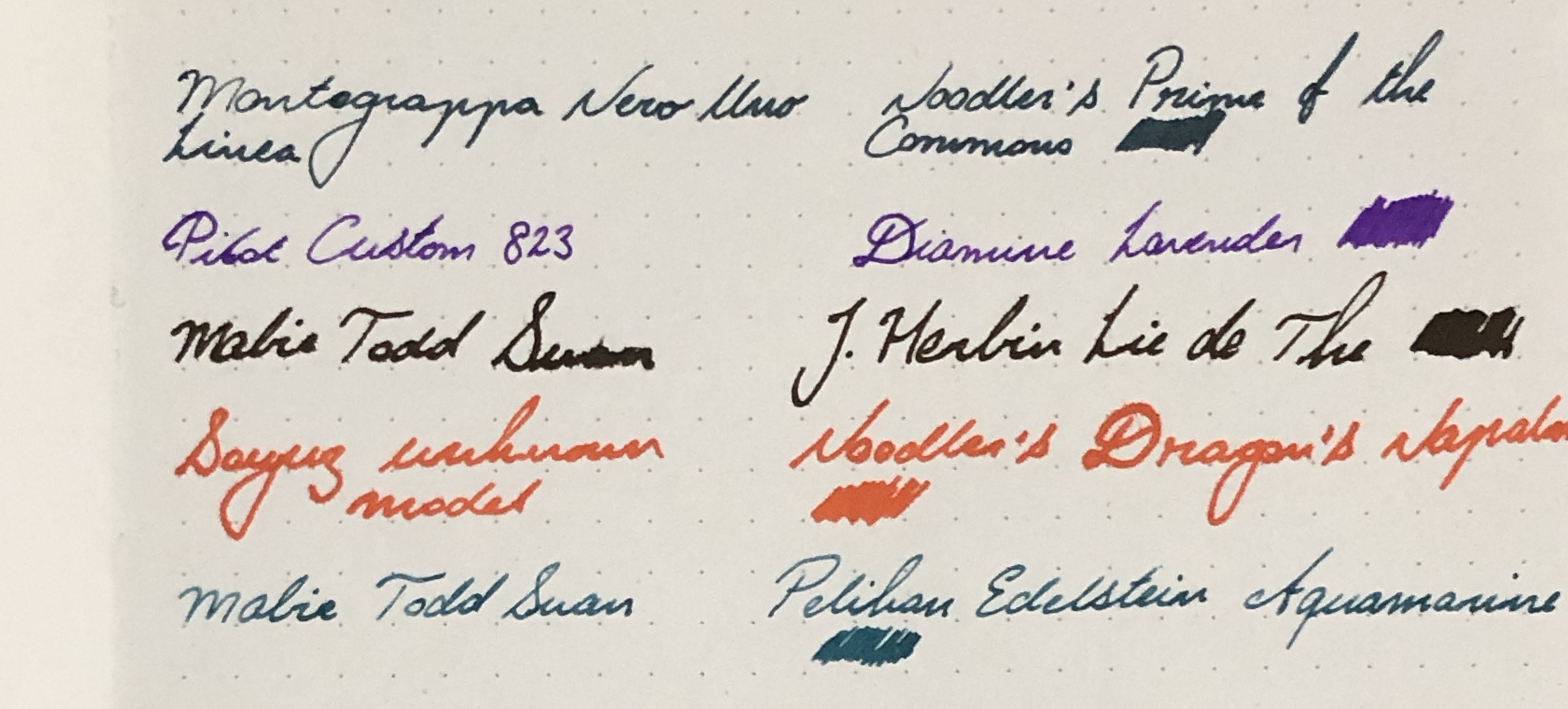

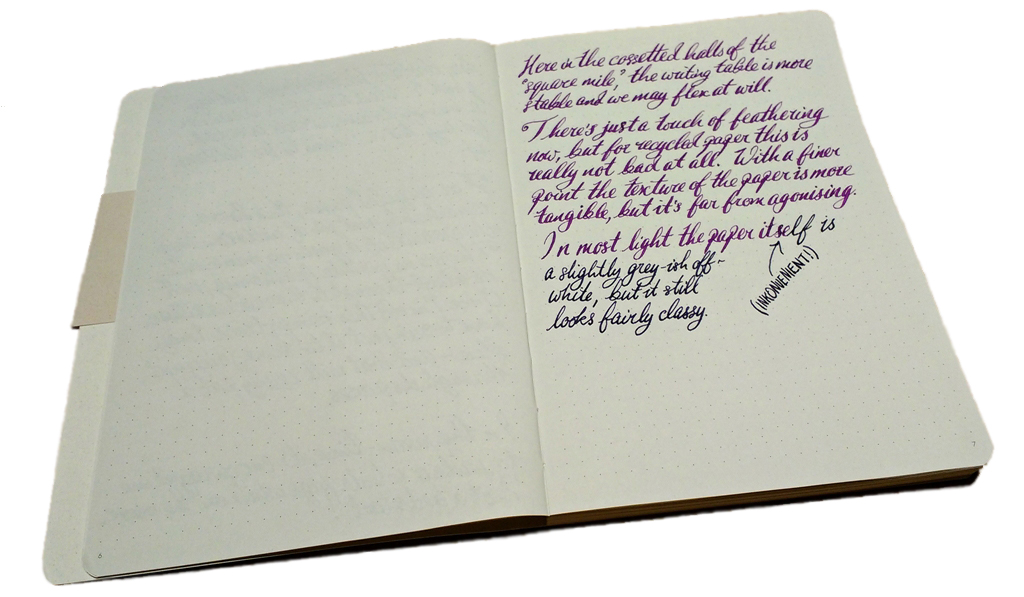
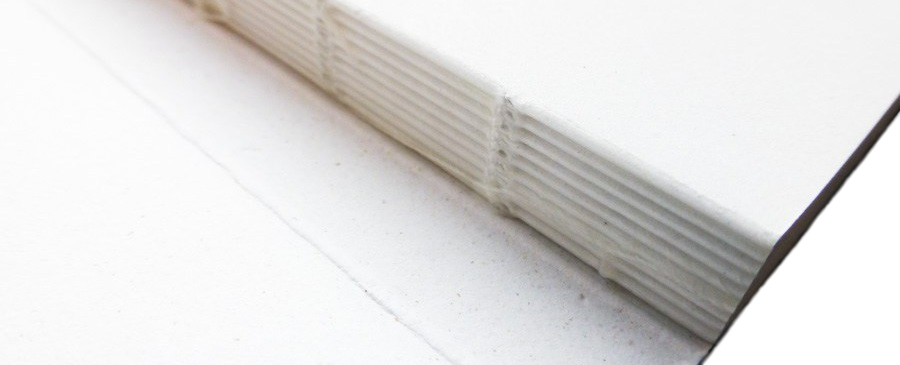

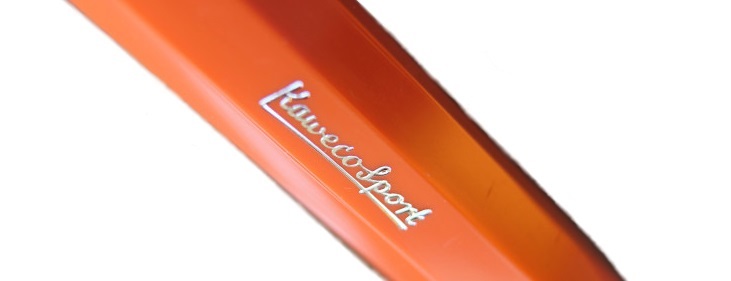 How it looks The shape is, of course, the same as for all Sports. The colour is a reliably foxy dark orange (don’t show it a beagle), with a few silvery highlights. It’s a classy presentation.
How it looks The shape is, of course, the same as for all Sports. The colour is a reliably foxy dark orange (don’t show it a beagle), with a few silvery highlights. It’s a classy presentation.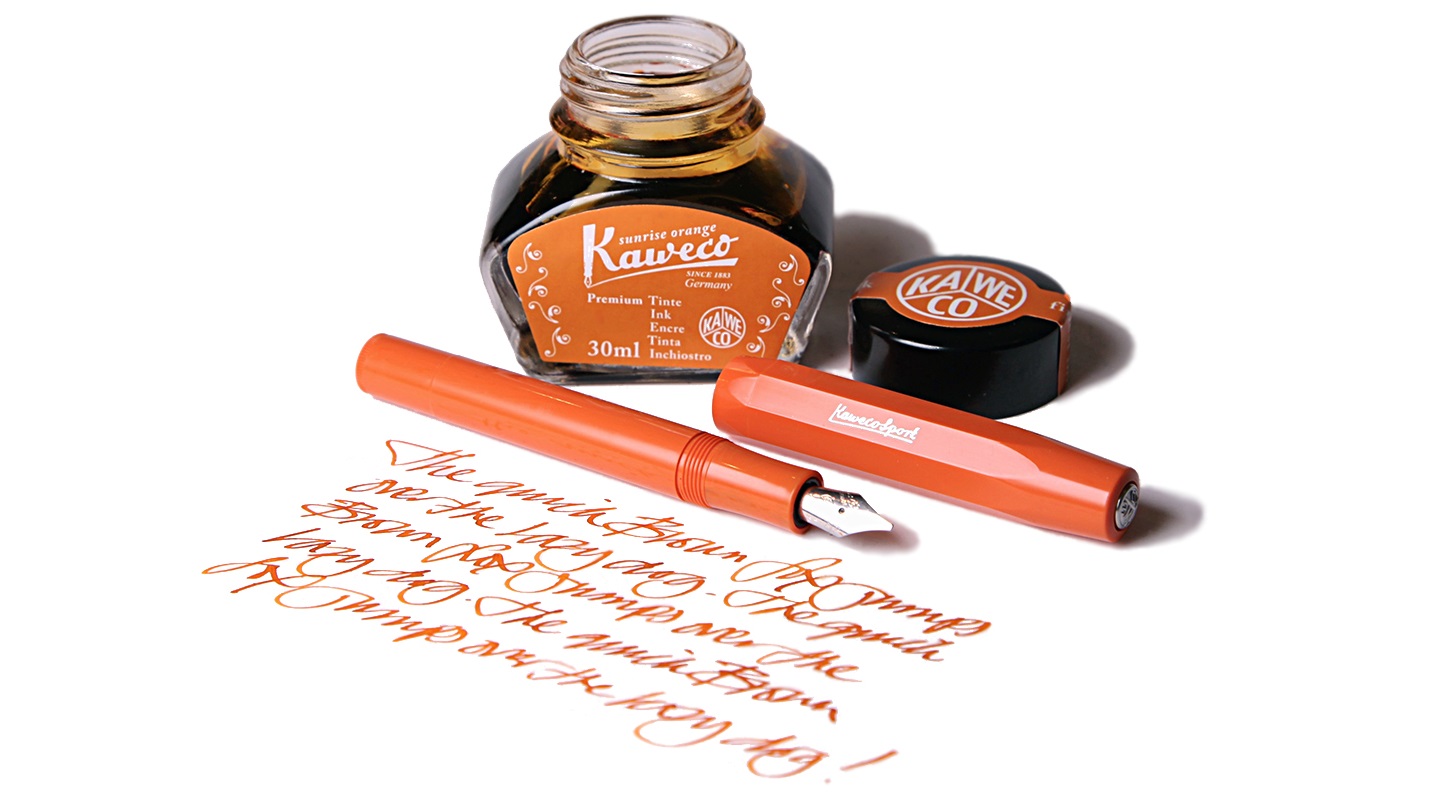
 How it fills The Sport has a legion of fans who also own a syringe, and refilling a cartridge is probably the best way to get a decent supply of ink. There is also a tiny push-rod converter, and it actually does work, but the ink capacity is very modest.
How it fills The Sport has a legion of fans who also own a syringe, and refilling a cartridge is probably the best way to get a decent supply of ink. There is also a tiny push-rod converter, and it actually does work, but the ink capacity is very modest.
 VFM At under £20, this is decent value – no complaints there.
VFM At under £20, this is decent value – no complaints there. If this isn’t quite your cup of tea, but almost… Pick a different Sport; there are dozens to choose from!
If this isn’t quite your cup of tea, but almost… Pick a different Sport; there are dozens to choose from! Our overall recommendation If you like the colour, and you’re already a happy owner of a Sport or two, get one before it bounds over the hedge.
Our overall recommendation If you like the colour, and you’re already a happy owner of a Sport or two, get one before it bounds over the hedge.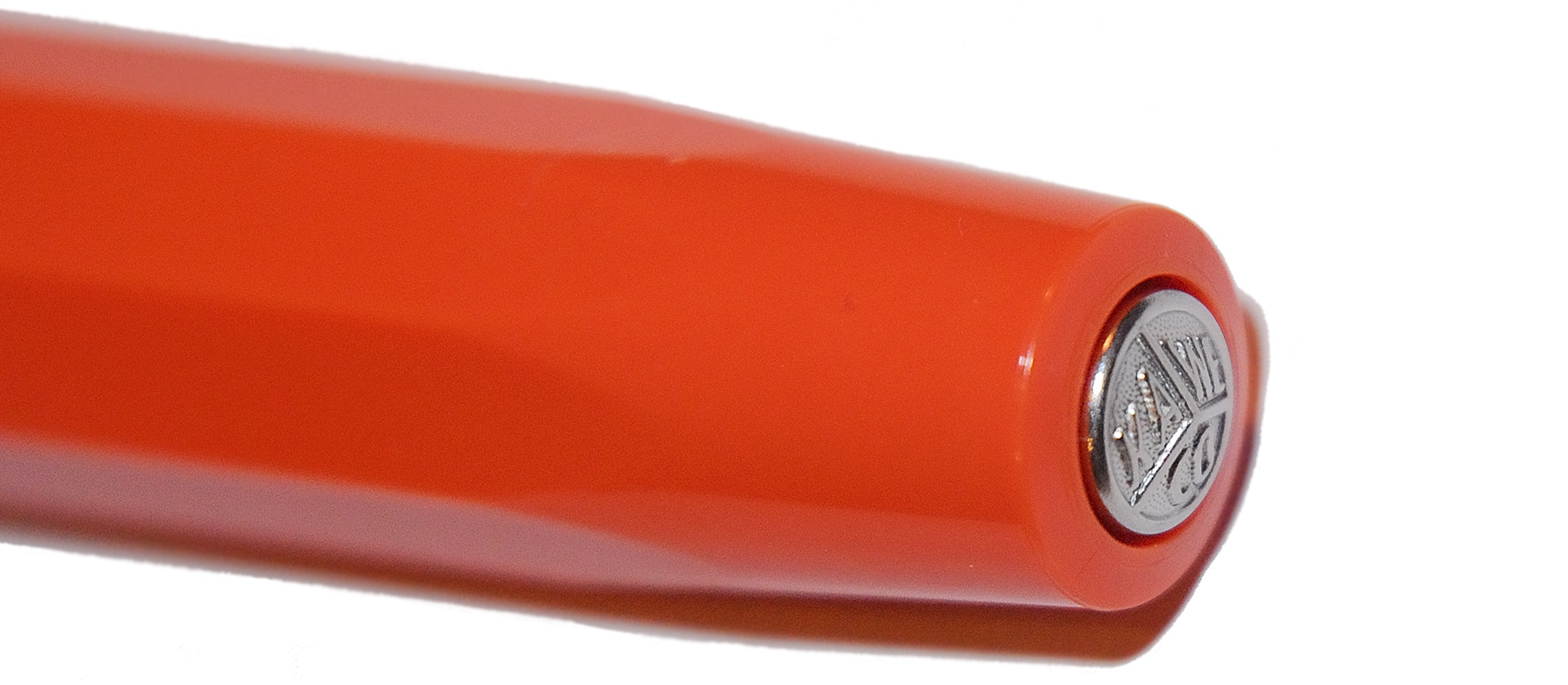 This meta-review references:
This meta-review references: A little bit of history Italix is an increasingly legendary name in fountain pen circles, having been made famous by the Parson’s Essential model in particular, and we’ve reviewed a couple of their models very positively before. The usual modus operandi is to commission an inexpensively-manufactured body from China and fit it with a high-quality German (generally JoWo) nib which has been ground, fettled and finished by the proprietor – Mr.Pen himself. It’s been a winning formula previously, so we were keen to get our hands on the latest offering…
A little bit of history Italix is an increasingly legendary name in fountain pen circles, having been made famous by the Parson’s Essential model in particular, and we’ve reviewed a couple of their models very positively before. The usual modus operandi is to commission an inexpensively-manufactured body from China and fit it with a high-quality German (generally JoWo) nib which has been ground, fettled and finished by the proprietor – Mr.Pen himself. It’s been a winning formula previously, so we were keen to get our hands on the latest offering…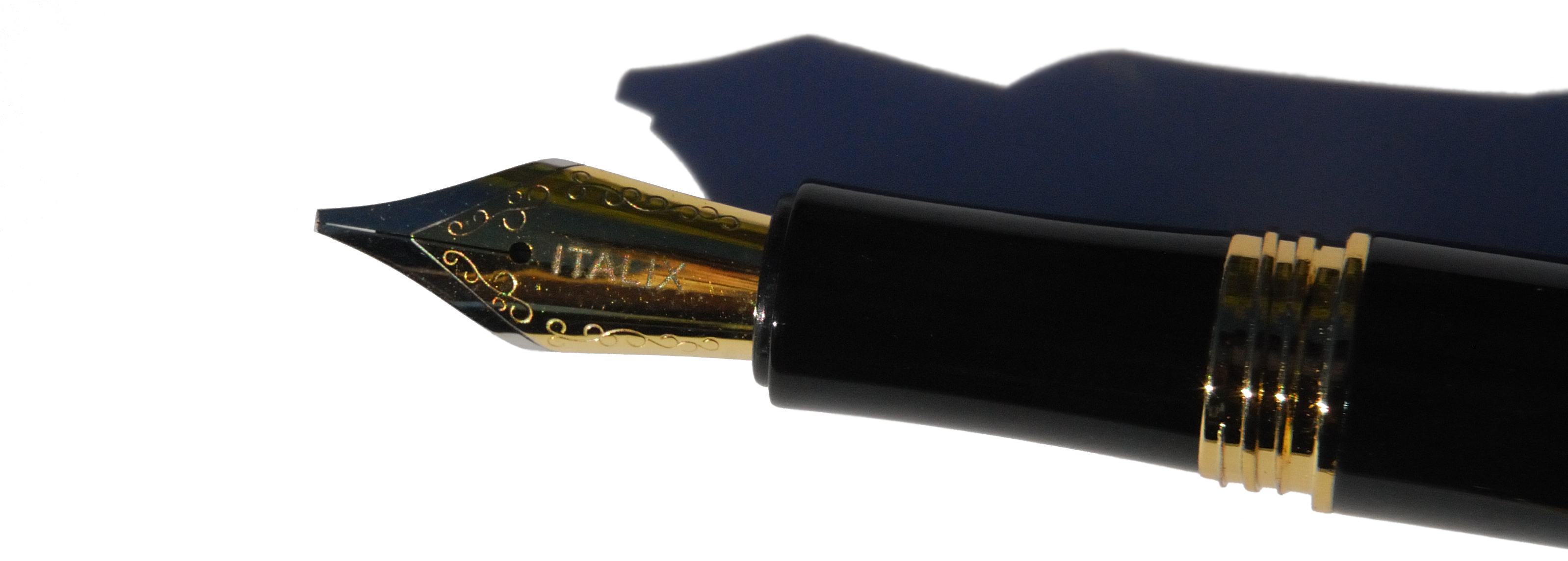
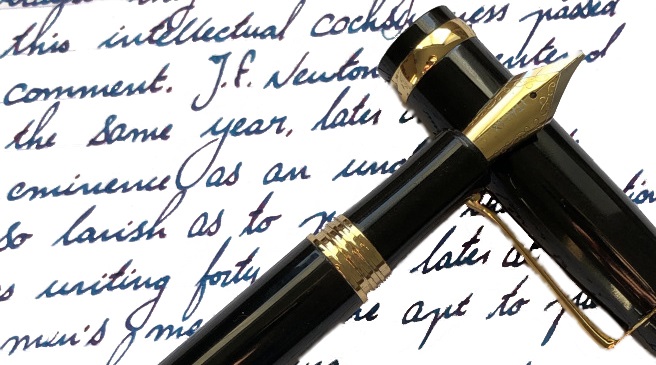
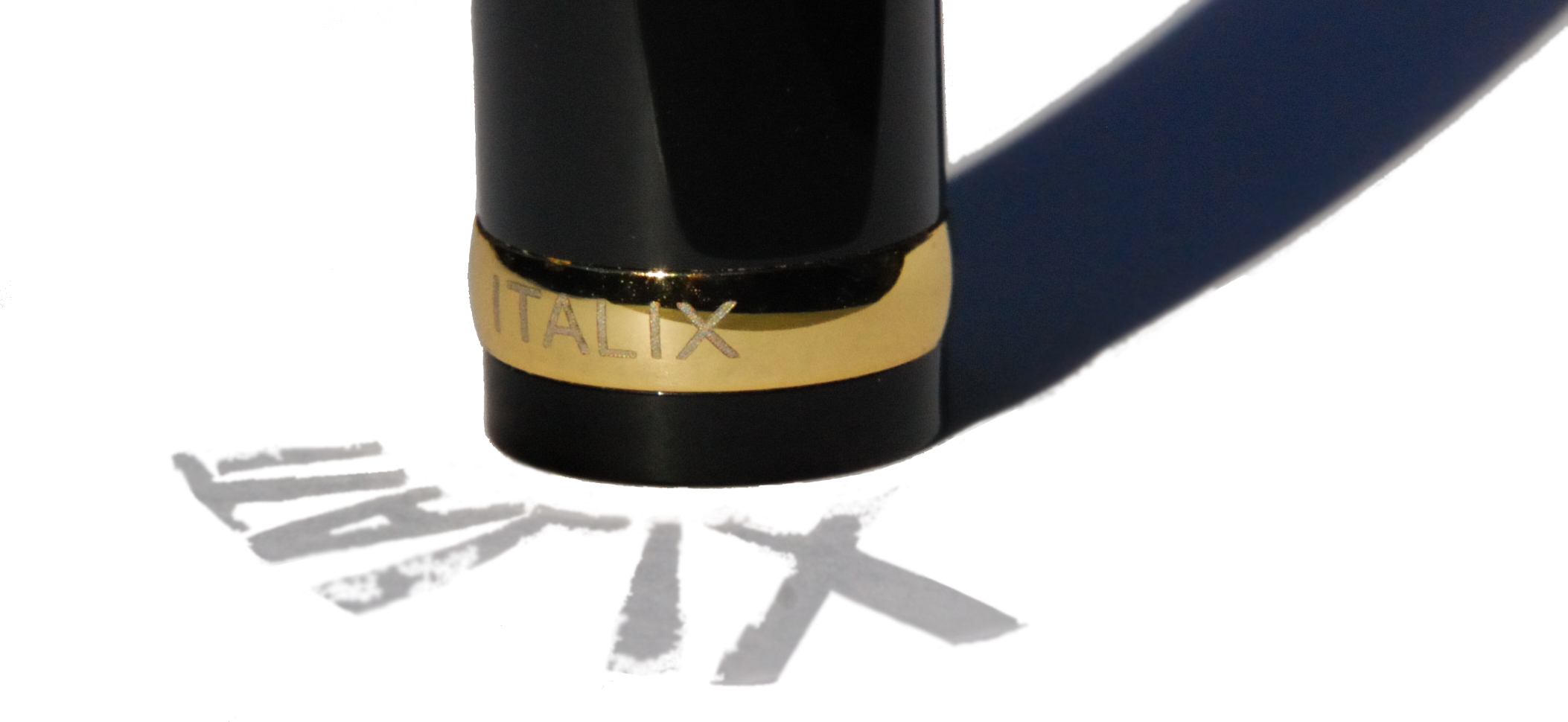


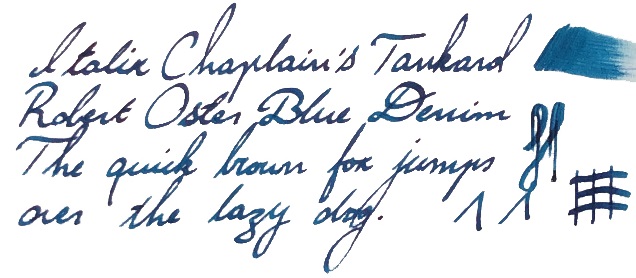
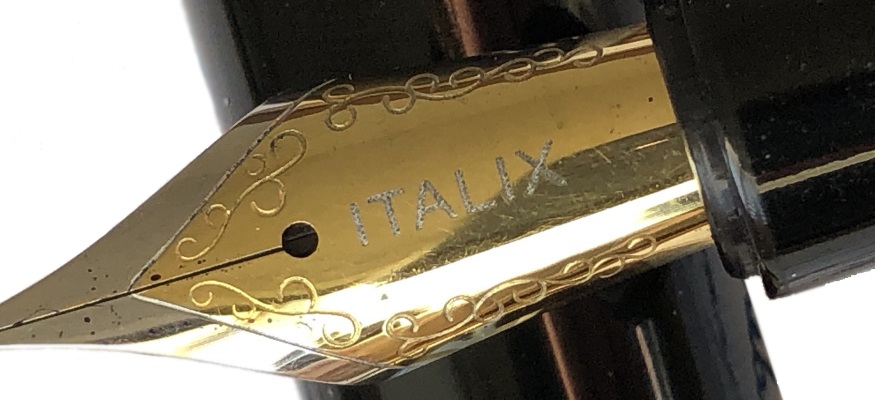




 Thanks to Mr. Pen for kindly providing this review sample.
Thanks to Mr. Pen for kindly providing this review sample.